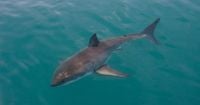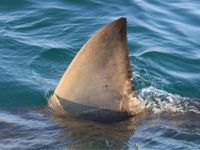In the early hours of September 30, 2025, a rare and startling event unfolded in the chilly darkness of the Pacific Ocean: a long-distance swimmer was bitten by a shark while attempting the grueling 20-mile crossing from Santa Catalina Island to the Southern California mainland. The incident, which occurred around 1:30 a.m. about 12 miles off the coast of Catalina Island, has sent ripples through the open water swimming community and prompted renewed attention to the region’s marine life.
According to the Los Angeles Fire Department (LAFD), the swimmer—identified in multiple reports as a 54-year-old man, and in some accounts as a UK-based athlete—was participating in a marathon swim, a feat that is part of the prestigious Triple Crown of Open Water Swimming. This trio also includes the English Channel and Manhattan’s 20 Bridges Swim, making the Catalina Channel a bucket-list challenge for endurance swimmers worldwide. The swim is so popular that, as Patch notes, over 700 people have completed solo crossings since 1927.
Most Catalina Channel attempts begin at midnight. Why such an odd hour? As LAFD boat pilot Shaun Corby explained to KTLA, “Swimmers often start at midnight to avoid afternoon winds.” The logic is simple: calmer seas and fewer vessels make for safer passage, though the darkness adds a layer of challenge—and, as this week’s events revealed, a touch of risk.
The swimmer was not alone in the water. A trailing support boat, a standard safety measure for such swims, monitored his progress. Somewhere near Doctor’s Cove—about 8 to 12 miles from the island—a shark, described by officials as a 3- to 4-foot-long white shark, suddenly appeared and bit the man. The species was not definitively confirmed, but fire officials and marine biologists suspect it was a juvenile great white, a common sight along the Southern California coast during warmer months. “It sounded like a three-to-four-foot white shark,” Corby told Fox 11. “It just nipped at his leg and his foot, then took off.”
Accounts from McClatchy News and the Los Angeles Times add further detail: the shark first bit the swimmer’s hand, and when he attempted to kick it away, it bit his foot. Despite the frightening encounter, the swimmer remained conscious and alert. “He was awake and talking and sitting up,” LAFD Capt. Adam VanGerpen told McClatchy News. “He suffered only mild distress.” By the time the LAFD’s fireboat arrived—roughly 40 minutes after the emergency call—the swimmer’s wounds were already wrapped by his support crew.
Paramedics boarded the vessel and tended to the man, who was then transported to a local hospital. He was listed in fair condition and, according to SFGATE, even expressed disappointment at not being able to finish his swim. Fire officials emphasized the non-life-threatening nature of his injuries, describing them as minor cuts to his leg, hand, and foot. The swimmer was taken to a nontrauma facility, a testament to the relatively mild outcome of what could have been a much graver incident.
The rarity of such attacks was underscored in every official statement. “It’s a pretty popular swim for long-distance swimmers,” Corby told KTLA. “This is a super-rare incident. I don’t know what the underlying circumstances were, but shark bites are pretty minimal here.” VanGerpen, with 25 years at the LAFD, said he had never heard of a shark attack off Catalina in his career. John Carlson of the National Oceanic and Atmospheric Administration echoed this sentiment, telling CNN, “You have a better chance of getting in a car accident and being injured on your way to the beach than you do actually when you get to go swimming.”
Statistics back up these reassurances. Between 1959 and 2010, there were 89 documented shark bites in California waters, including seven fatalities, according to the International Shark Attack File. By contrast, lightning strikes claimed 34 lives from 1959 to 2016, and rip currents caused 361 fatalities in the United States between 2004 and 2013. In the last decade, California has averaged just 1.8 shark attacks per year, according to data cited by SFGATE.
Why are juvenile great whites so common along this stretch of coast? The Shark Lab at California State University, Long Beach, explains that the region has become a nursery for white sharks. Females give birth in the warm, food-rich waters from Santa Barbara to San Diego, and the young sharks—measuring 4 to 5 feet at birth—are already adept hunters. These juveniles are most frequently spotted from April to October, before migrating south to Mexico in late fall.
For those who encounter a shark, experts offer practical advice. Richard Peirce, former chair of the Shark Trust, told CNN that panicking is the worst response: “Don’t start splashing around – you’re just going to excite, incite and encourage the shark’s interest.” Instead, swimmers should maintain eye contact and read the shark’s body language. If attacked, Peirce recommends keeping the animal in sight and slowly backing away toward shallow water, never playing dead.
The incident has sparked conversations about swimmer safety and the unpredictable nature of open water challenges. Yet, as Corby observed, the odds of a shark bite remain slim. Swimmers face greater dangers from currents, vessel traffic, and hypothermia than from sharks. The challenge of the Catalina Channel lies not just in its distance, but in its ever-changing conditions—fluctuating temperatures, strong currents, and, yes, the occasional curious predator.
Despite the scare, the swimmer’s resilience and the quick response of his crew and emergency services ensured a positive outcome. The marathon swim community, while shaken, remains undeterred. After all, as history shows, the lure of the Triple Crown is strong—and the ocean, for all its risks, continues to draw those seeking to test their limits.


